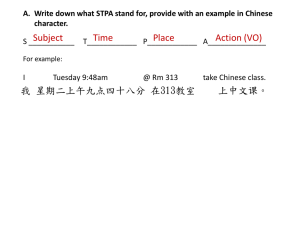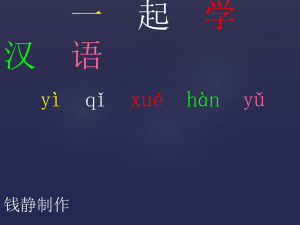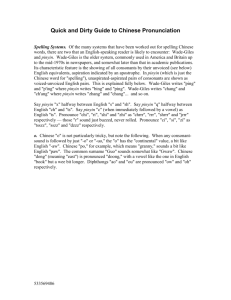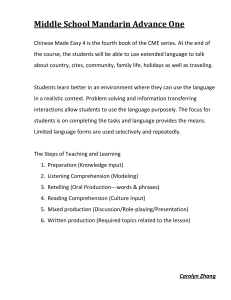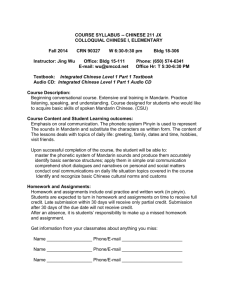PDF format - University of Cambridge
advertisement
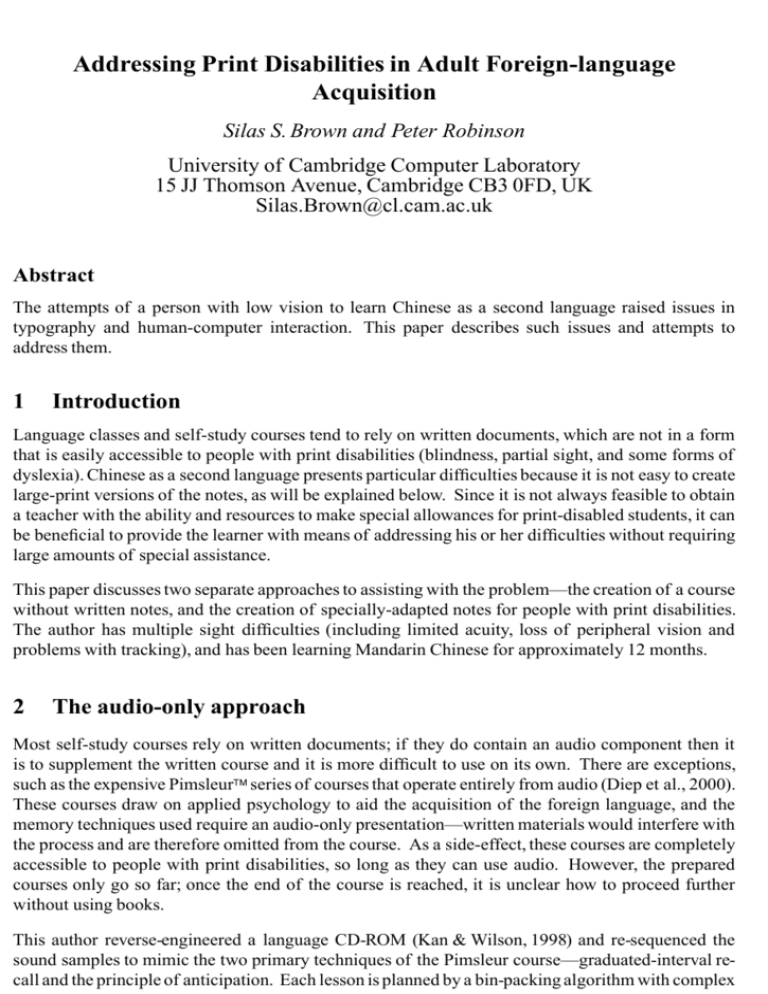
Addressing Print Disabilities in Adult Foreign-language Acquisition Silas S. Brown and Peter Robinson University of Cambridge Computer Laboratory 15 JJ Thomson Avenue, Cambridge CB3 0FD, UK Silas.Brown@cl.cam.ac.uk Abstract The attempts of a person with low vision to learn Chinese as a second language raised issues in typography and human-computer interaction. This paper describes such issues and attempts to address them. 1 Introduction Language classes and self-study courses tend to rely on written documents, which are not in a form that is easily accessible to people with print disabilities (blindness, partial sight, and some forms of dyslexia). Chinese as a second language presents particular difficulties because it is not easy to create large-print versions of the notes, as will be explained below. Since it is not always feasible to obtain a teacher with the ability and resources to make special allowances for print-disabled students, it can be beneficial to provide the learner with means of addressing his or her difficulties without requiring large amounts of special assistance. This paper discusses two separate approaches to assisting with the problem—the creation of a course without written notes, and the creation of specially-adapted notes for people with print disabilities. The author has multiple sight difficulties (including limited acuity, loss of peripheral vision and problems with tracking), and has been learning Mandarin Chinese for approximately 12 months. 2 The audio-only approach Most self-study courses rely on written documents; if they do contain an audio component then it is to supplement the written course and it is more difficult to use on its own. There are exceptions, such as the expensive Pimsleur series of courses that operate entirely from audio (Diep et al., 2000). These courses draw on applied psychology to aid the acquisition of the foreign language, and the memory techniques used require an audio-only presentation—written materials would interfere with the process and are therefore omitted from the course. As a side-effect, these courses are completely accessible to people with print disabilities, so long as they can use audio. However, the prepared courses only go so far; once the end of the course is reached, it is unclear how to proceed further without using books. This author reverse-engineered a language CD-ROM (Kan & Wilson, 1998) and re-sequenced the sound samples to mimic the two primary techniques of the Pimsleur course—graduated-interval recall and the principle of anticipation. Each lesson is planned by a bin-packing algorithm with complex constraints based on the timing used in Pimsleur. Since Pimsleur recommends that the tape controls are not used, the program has no user interface (it cannot be controlled); it simply runs in the background playing samples to the loudspeakers. The program was run for 30 minutes each day, saving its progress after each run. Each day’s lesson introduced fiv enew words and revised recently-learned and older words; new words were repeated more frequently, and the words were preceded by prompts in the learner’s first language to give the learner an opportunity to recall and speak them before they are confirmed. The code is approximately 600 lines of Python. The resulting course makes no attempt to teach grammar; it is limited to vocabulary building. However, that is the most important task for ongoing language acquisition (after the foundation has been laid). Since the program will use any sound samples and its vocabulary can be progressively expanded, the author was able to construct an ongoing course with the aid of native friends who were willing to record new words. Although this is special assistance, the amount of time required is minimal, and the natives do not have to be trained teachers (although it helps if they articulate well). Since the learner is involved in the recording process, the vocabulary that is taught can be tailored to the learner’s interests, and can theoretically be expanded indefinitely so long as co-operative native speakers are available. In this case the vocabulary database was expanded whenever it was possible to obtain a recording session with a native; this was usually the limiting factor in the learner’s progress. 2.1 Sound-editing software One issue that was raised is the accessibility of digital audio editing software. The program required each sampled word to be in a separate sound file. However, since the learner wished to minimise his demand on the native speakers, he preferred to make a continuous recording of the entire session and edit it later to isolate the individual samples. This proved difficult because sound editing software is graphical and relies on intensive mouse-based operations. Consequently, the author implemented a separate program that acts as a non-graphical sound editor; while the recording is being played, various keystrokes are available to indicate what should be done with the sound, e.g. “start a new sample here” or “discard the current sample”. Since this was based on reaction times, a second attempt was often needed, but the overall task was completed much more quickly and with less irritation; only in rare cases was it necessary to invoke the graphical editor to trim a sample more finely . This method imposes a restriction on the order of the words spoken. Since words in the target language must be correlated with words in the learner’s first language, and since the editing is done in real-time so there is no time to type explicit labels for the samples, the first-language and secondlanguage words must be recorded in the same order or interleaved. This was not normally a problem, but one of the native speakers had difficulty understanding this requirement. 3 Adapting the written notation When teaching written Chinese to Western students, Chinese characters are often written with small pronunciation guides, and sometimes the meaning of each character or group of characters is also written in the language of the student. There are several systems for indicating pronunciation; some use special phonetic symbols (such as zhuyin) and others employ the Latin alphabet. These pinyin (alphabetical) systems use either numbers or special accents to indicate tonal inflection, and they use various different spellings that are not always intuitive to English people (this is a common source of bad pronunciation). Different students prefer different pinyin systems, and many beginners prefer to devise their own systems for private use and then “wean” themselves onto the standard notation. Such weaning is usually done by writing both notations in parallel and progressively deleting parts of the private notation according to the student’s progress; the same method can be used to progress toward reading the Chinese characters directly. If a learner wishes to participate in a Chinese-language event, his or her notes might contain four different notations in parallel—Chinese characters, pinyin, the student’s first language, and the private notation(s). If the text is a song or a presentation then there might be additional notations to indicate music or presentational techniques. 3.1 3.1.1 Requirements Disproportionate scaling The “ruby” system (“Line composition rules”, 1995) of writing small-print pinyin above the characters is difficult for partially-sighted readers. If it is enlarged without adjustment then the result can be unweildy—when the smaller characters are a readable size, the larger characters become excessively large. Consequently, the relative difference between the sizes of characters must be reduced when large print is used. 3.1.2 Tracking People with certain sight conditions can lose track of which line they are reading; this problem is accentuated when there are many notations in parallel and it is easy to become “lost”, particularly at line and page boundaries. If the relative differences in sizes of the notations are reduced in accord with the above requirement, then this accentuates the tracking problem. In addition, if weaning is in progress then some lines will have missing words, forcing the reader to frequently look for the information in different lines; if the reader has a tracking problem then this will make the text very difficult to read aloud at an acceptable pace. This author addressed tracking by applying the Gestalt laws of perception. The different notations are printed in different colours, helping to differentiate them (shades of grey can also be effective); they were then brought very close together (almost overlapping) to make it easier to move from one notation to another and to leave a more obvious space between the blocks of lines. The use of colour to differentiate the notations compensated for the crowding that would otherwise result from their clustering. As a further aid to tracking, gaps in the notation of primary focus are filled by duplicate copies of other lines. For example, if the reader is primarily using the pinyin, but some of it is missing because the reader should know the characters, then these characters are copied into the gaps on the pinyin line, so that it is not necessary to look away from that line to find them. This is particularly useful if the two notations are not adjacent because the learner feels that other notations (such as the meaning) should be closer to the primary focus at this stage. 3.1.3 Production Typesetting parallel lines usually requires special-purpose software, which is difficult to adapt to the above requirements. Alternatively the positioning can be done graphically, either with handwriting or a graphical wordprocessor, but this is arduous for the sight-impaired learner to do without assistance. Using a conventional Chinese input method was also challenging. Consequently, new software was needed. 3.2 Implementation A customised Chinese input method was produced by extending the Emacs editor; this allows a dictionary to be searched using either pinyin or English to obtain the Chinese characters, and it can display suitably large text. Once a desired entry is located, the entire dictionary entry (which is brief) is used as a starting point for the parallel notations (characters, English and pinyin), and some private notation is generated automatically from the pinyin by using the learner’s preferred re-writing rules. Hence the production of a document is largely a series of dictionary searches with a little subsequent editing. If Chinese characters have already been provided then it can be unclear how they should be grouped into words (which can be formed of two or more characters), and in this case it is useful to keep the pinyin together so that its grouping can be changed quickly (for example, by replacing a space with a hyphen). Sometimes Chinese characters may not be available at all. If the input has been provided by others then it may be in a more esoteric format, such as song lyrics, where a line of pinyin is placed above a line of characters, and pairs of lines from different stanzas are interleaved. The author’s transformation framework 4DML (Brown & Robinson, 2002) allows this input to be transformed into the language of the Chinese-capable typesetting package CJK–LATEX for layout. 4DML uses a “model” (outline) of the desired output, which facilitates adjusting the notation as needed—the fonts, spacing, colours, order of lines, and state of weaning (which characters and which aspects of pinyin are assumed to be known) might all change over time and across different students, and there are other requirements in collaborative settings such as allowing more space for handwritten corrections. These changes are achieved by adjusting the model. A different model was used to send the output as plain text for a Chinese-capable email client. In figure 1, the blue private notation has mostly been taken away and a few Chinese characters are assumed to be known. Syllable separation dots (which are not standard in Chinese) have been used, as have parentheses to indicate a higher level of grouping. 4 Conclusion This paper discussed two approaches to addressing print disabilities in language learning. The author successfully used them to learn Chinese and participate in Chinese-language events. This is an ongoing process and future refinements are possible. The approaches demonstrate how technology and notational transformations can be used to allow a disabled person to participate in society more ·wén) kě·shı̀ shr shr (Wǒ shı̀·tú speak I attempt Chinese but ·hǎo) yı̄n·tszcı̌ (wǒ· xı̀n) (wǒ therefore I speak nogood, my letter ). Rú·goar doar dà·duō (yı̄ng·wén shū·xiě mostly write English "!Ifguǒ tiān·qı̀ hǎo) (jı̄n·tiān· fine, #today’s $ weather $&% duı̀· ·qı̀ I’m sorry, etc Figure 1. Example of an alternative notation for learning Chinese in large print. (Box represents the sheet of paper, shown here 1/9 actual size.) independently. They also potentially demonstrate how addressing the needs of disabled people can improve life for others—the author has had several requests for copies of the software (but the legality of distributing a derivative of the Pimsleur method is unclear). It is possible that approaches such as these will become more mainstream as the need for universal design in education is recognised. Acknowledgement: The author is supported by a studentship from the UK’s Engineering and Physical Sciences Research Council (EPSRC). References Brown, S. S., & Robinson, P. (Mar 2002). Automatically Rearranging Structured Data for Customised Special-Needs Presentations. In Keates, S., Clarkson, P. J., Langdon, P., & Robinson, P. (Eds.), Universal Access and Assistive Technology: proceedings of the Cambridge Workshop on UA and AT, pages 109–118. Diep, M. L. et al. (2000). Chinese (Mandarin). Pimsleur Language Programs. Simon & Schuster Audio. Similar courses are available for other languages. Kan, Q., & Wilson, D. (1998). Colloquial Chinese CD-ROM. Routledge. Japanese Standards Association. (1995). Line composition rules for Japanese documents. JIS X 4051–1995.
